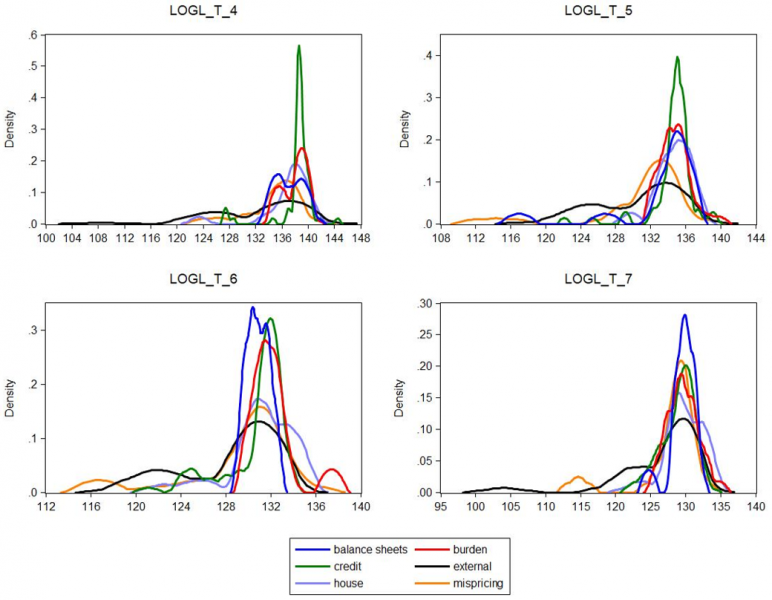References
Alessi, L. and Detken, C., 2019. Identifying excessive credit growth and leverage. Journal of Financial Stability, 35. pp. 215-225. https://doi.org/10.1016/j.jfs.2017.06.005.
Ang, A. and Timmermann, A., 2012. Regime changes and financial markets. Annual Review of Financial Economics, 4, pp. 313-337. https://doi.org/10.11 46/annurev-financial-110311-101808.
Anundsen, A. K. [et al.], 2016. Bubbles and crises: The role of house prices and credit. Journal of Applied Econometrics, 31, pp. 1291-1311. https://doi.org/10.1002/jae.2503.
Borio, C. and Drehmann, M., 2009. Assessing the Risk of Banking Crises – Revisited. BIS Quarterly Review, (March), pp. 29-46.
Borio, C. and Lowe, P., 2002. Asset prices, financial and monetary stability: exploring the nexus. BIS Working Papers, No. 114. https://doi.org/10.2139/ssrn.846305.
Candelon, B., Dumitrescu, E-I. and Hurlin, C., 2012. How to Evaluate an Early-Warning System: Toward a Unified Statistical Framework for Assessing Financial Crises Forecasting Methods. IMF Economic Review, 60, pp. 75-113. https://doi.org/10.1057/imfer.2012.4.
Cardarelli, R., Elekdag, S. and Lall, S., 2011. Financial stress and economic contractions. Journal of Financial Stability, 7(2), pp. 78-97. https://doi.org/10. 1016/j.jfs.2010.01.005.
CNB, 2022. Statistical data. Zagreb: Croatian National Bank.
Davis, E. P. and Karim, D., 2008. Comparing early warning systems for banking crises. Journal of Financial Stability, 4(2), pp. 89-120. https://doi.org/10. 1016/j.jfs.2007.12.004.
Detken, C. [et al.], 2014. Operationalising the countercyclical capital buffer: indicator selection, threshold identification and calibration options. ESRB Occasional Paper, No. 2014/5. https://doi.org/10.2139/ssrn.3723336.
Doz, C., Ferrara, L. and Pionnier, P., 2020. Business cycle dynamics after the Great Recession: An extended Markov-Switching Dynamic Factor Model. OECD Statistics Working Papers, No. 2020/01. https://doi.org/10.1787/9626dda3-en.
Drehmann, M. and Juselius, M., 2012. Do debt service costs affect macroeconomic and financial stability? BIS Quarterly Review, September 2012.
Duprey, T. and Klaus, B., 2017. How to predict financial stress? An assessment of Markov switching models. ECB Working Paper, No. 2057. https://doi.org/10.2139/ssrn.2968981.
ESRB 2018. The ESRB handbook on operationalising macroprudential policy in the banking sector. European Systemic Risk Board.
ESRB, 2014. Recommendation of the European Systemic Risk Board of 18 June 2014 on guidance for setting countercyclical buffer rats (ESRB/2014/1). Official Journal of the European Union C 293/1.
Giese, J. [et al.], 2014. The credit-to GDP gap and complementary indicator for macroprudential policy: evidence from the UK. International journal of finance and economics, 19(1), pp. 25-47. https://doi.org/10.1002/ijfe.1489.
Giglio, S., Bryan, K. and Pruitt, S., 2016. Systemic Risk and the Macroeconomy: An Empirical Evaluation. Journal of Financial Economics, 119(3), pp. 457-471. https://doi.org/10.1016/j.jfineco.2016.01.010.
Gneitinga, T. and Ranjanb, R., 2011. Comparing Density Forecasts Using Threshold- and Quantile-Weighted Scoring Rules. Journal of Business and Economic Statistics, 29(3), pp. 411-422. https://doi.org/10.1198/jbes.2010.08110.
Kaminsky, G. L. and Reinhart, C. M., 1999. The Twin Crises: The Causes of Banking and Balance-of-Payments Problems. American Economic Review, 89(3), pp. 473-500. https://doi.org/10.1257/aer.89.3.473.
Kauko, K., 2014. How to foresee banking crises? A survey of the empirical literature. Economic Systems, 38(3), pp. 289-308. https://doi.org/10.1016/j. ecosys.2014.01.001.
Klomp, J., 2010. Causes of banking crises revisited. The North American Journal of Economics and Finance, 21(12), pp. 72-87. https://doi.org/10.1016/j.najef.2009.11.005.
Lang, J-H. [et al.], 2019. Anticipating the bust: a new cyclical systemic risk indicator to assess the likelihood and severity of financial crises. Occasional Paper Series, No. 219. https://doi.org/10.2139/ssrn.3334835.
O’Brien, M. and Wosser, M., 2021. Growth at Risk & Financial Stability. Financial stability notes, 2021(2)
Schularick, M. and Taylor, A. M., 2012. Credit booms gone bust: monetary policy, leverage cycles, and financial crises, 1870-2008. The American Economic Review, 1022, pp. 1029-1061.
https://doi.org/10.1257/aer.102.2.1029.
Slingenberg, J. W. and de Haan, J., 2011. Forecasting Financial Stress. De Nederlandsche Bank Working Paper, No. 292. https://doi.org/10.2139/ssrn.1951800.
Vermeulen, R. [et al.], 2015. Financial Stress Indices and Financial Crises. Open Economies Review, 26(3), pp. 383-406.
Vujčić, B. and Dumičić, M., 2016. Managing Systemic Risks in the Croatian Economy. BIS Paper, No. 861.




